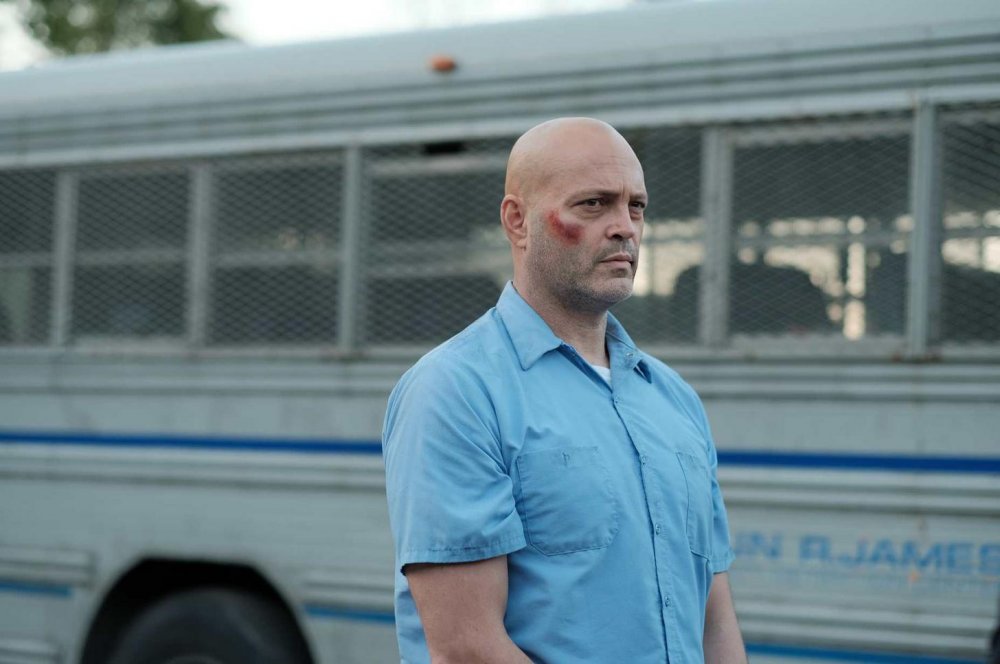S. Craig Zahler is the Miami-born writer-director who's come stealthily to prominence by hard-boiling some of our less fashionable genres, giving the resultant pulp a brute force you might well choose to look away from, but which you cannot deny. He broke through with 2015's Bone Tomahawk, a splicing of Western and horror tropes that yielded one or two sequences unlike anything you'd ever previously winced through in a cinema. His evident rejection of the usual pieties and niceties is again on display in Brawl in Cell Block 99, a cautiously distributed hybrid of crime melodrama and prison flick following bullet-headed drug trafficker Vince Vaughn into a stylised idea of the U.S. detention system. That earlier film was a plunge into the abyss, and just perhaps a sly comment on the perils of manifest destiny. The new one plays like a nihilist fable of violence rerouted to no better end, from the moment Vaughn's Bradley returns home from the car repair job he's just lost to discover evidence wife Lauren (Jennifer Carpenter) has been having an affair. Calmly, he orders her to go inside, then he methodically tears the guts out of her car by hand. This leftfield instance of anger management isn't something we'd have witnessed in a Bogart or Cagney movie - but then Zahler's USP would seem to be an unexpected, ferocious perversity. What follows confirms him not as a dreamweaver, exactly, but a generator of sustained, unflinching nightmares. Here is a Tarantino with the reassuring ironic smirk forcibly removed, making films that feel as much like warning signs in a psychologist's report as they do entertainments in the conventional sense. Approach at your own risk.
Some have questioned this marked absence of PC from Zahler's CV; others have positioned him as a successor to the fascinatingly wayward likes of Sam Fuller and John Milius. I found Bone Tomahawk horribly compelling, in spite of its depiction of an indigenous people as bloodthirsty savages, which turned back forty-odd years of progressive thinking within the Western genre. (Dances with Wolves it was not.) That Bradley's once-ordered life goes completely off-course when his employer does a deal with some disreputable Mexicans threatens to mark Zahler as very much a filmmaker of the Trump era. Yet his interest in properly 18-rated, non-fantasy violence also makes him an interesting outlier at a time of blandly upbeat studio fare, and he's brutally honest and upfront with it, too. (The movie's first shot is of a can being crushed, cluing us in on anything that title might have left ambiguous; by the time of 2018's follow-up Dragged Across Concrete, pairing Vaughn with Mel Gibson, audiences couldn't say they didn't know what they were getting into.) The control evident in both the conflict-averse protagonist and the direction should be enough to hook you. After his DEA bust, Bradley's sent to The Fridge, a holding centre set out in a palette of light blues, where it becomes apparent Zahler is a cool cat dealing with characters who present as varyingly hot heads. He knows it will suffice to let the violence linger at the edge of shots, or just offscreen; that - contra Tarantino - it doesn't have to be front and centre for us to feel the tremor of threat, the lawlessness beneath society's surface civility. For an hour, Brawl exhibits a chilly calm, such that you might wonder why it's garnered the reputation it has. Yet as in his previous film, Zahler is simply luring us in before twisting our guts and smacking us around the head. Bad news is forthcoming when Udo Kier turns up as Bradley's first visitor behind bars - whereupon an oddly sedate melodrama becomes a far more urgent proposition, something akin to Prison Break with the network-TV inhibitor chip taken out.
That's not the only element missing here. Bone Tomahawk - expansive beyond its horrors - evoked a consoling sense of community, of different personalities being drawn together in the mire. (It was part John Carpenter, part Howard Hawks.) The prison of Cell Block 99, by contrast, looks curiously underpopulated; there's none of that heaving Sadean chaos one found amid the film's closest equivalent, HBO's Oz. A consequence is that the fight scenes are strikingly odd: Zahler's going for close-up, no-holds-barred realism, but much of the film's action is taking place in a vacuum, requiring ramped-up Foley work - all arm-snaps and ribcracks - by way of compensation. If the effects here are way more OTT than those of its predecessor (there's a face stomp that stays with you), the reduction of Carpenter's Lauren to not much more than narrative collateral suggests a certain absence of heart. Zahler may turn out to be one of those sociopath-directors who needs to keep making films like this to avoid being put behind bars himself; that's where the debate comes from, though it might be healthier for us all if he gets others to act out these impulses than it would be if he himself acted upon them. Still, there's a real toughness and hard-to-shake resilience about the pulp he's peddling here, coupled to a give-no-fucks styling-out that immediately elevates Brawl over those terminally throwaway Escape Plan movies, for one. (It's rather like one of those "BAD TO THE BONE" tattoos that were once all the rage in our less reputable drinking establishments: ugly as sin, but you have to respect the commitment involved.) Vaughn, for one, begins the hard labour of transforming himself from Hollywood laughing stock in an unusual hero role, in no convincing way likable, and yet somehow the best hope we have. For the first time in years, the actor looks truly engaged, like the leading man he once promised to be; once the celldoors close, we're right there in this hell with him, whether we like it or not.
Brawl in Cell Block 99 is now streaming on Netflix.

No comments:
Post a Comment